Essay on First Stage of Labour: Midwifery Strategies and Normalcy
VerifiedAdded on 2022/09/01
|5
|1401
|14
Essay
AI Summary
This nursing essay comprehensively addresses the management of the first stage of labour, emphasizing midwifery strategies to maintain normalcy and mitigate potential complications. The essay begins by outlining the stages of labour and the associated pain levels, focusing on the dilation of the cervix during the first stage. It highlights various strategies employed by midwives, including managing the amniotic sac, observing vaginal mucus, and monitoring muscle cramps. The essay underscores the importance of providing activities to alleviate pain and promote active labour, such as encouraging healthy breathing, warm showers, and adequate hydration. Furthermore, it discusses critical interventions like monitoring the amniotic fluid and providing emotional support to the patient. The essay concludes by emphasizing the significance of early intervention and the application of effective strategies to ensure a healthy and safe delivery, offering a valuable resource for nursing students seeking to understand and address the complexities of childbirth.
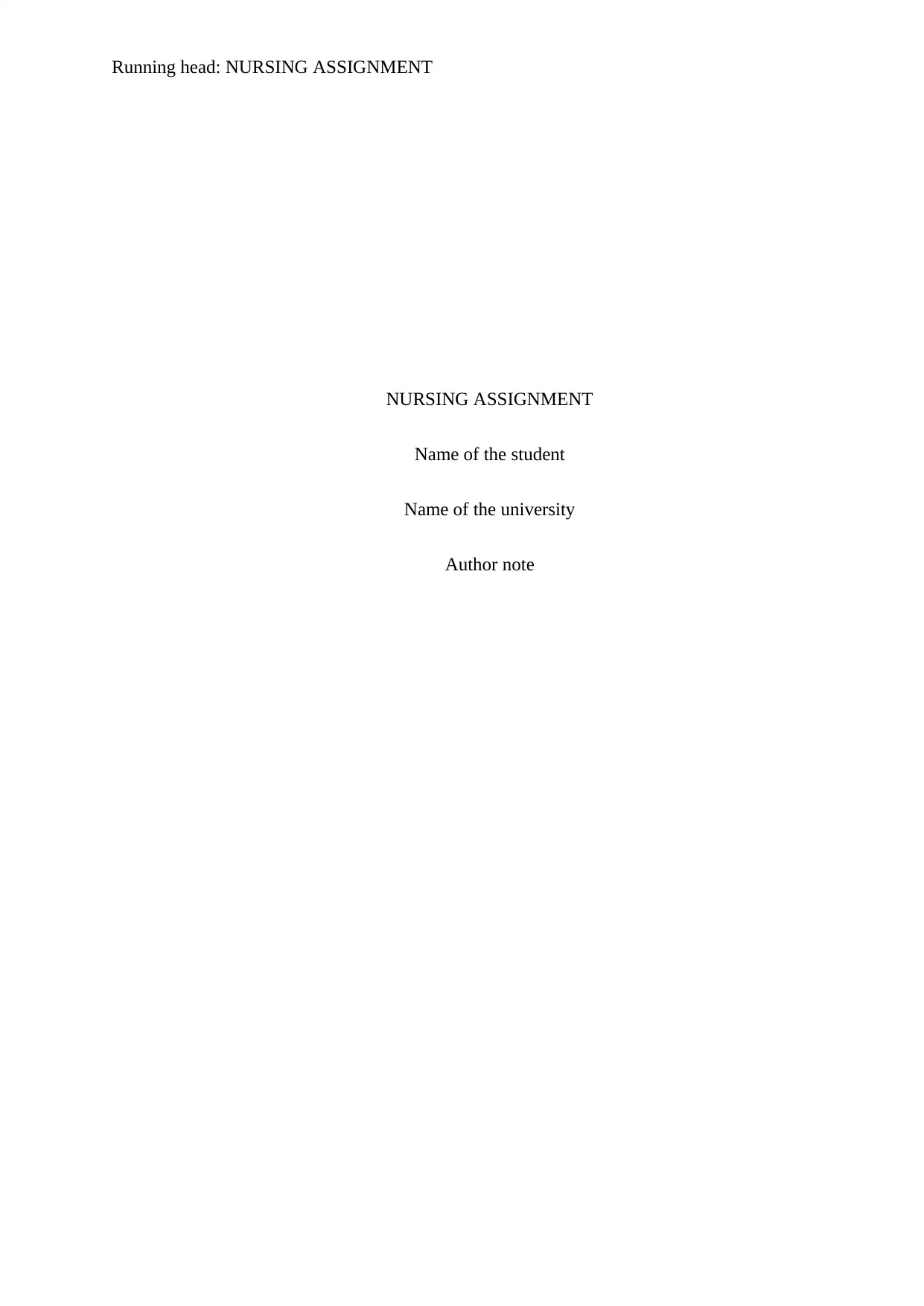
Running head: NURSING ASSIGNMENT
NURSING ASSIGNMENT
Name of the student
Name of the university
Author note
NURSING ASSIGNMENT
Name of the student
Name of the university
Author note
Paraphrase This Document
Need a fresh take? Get an instant paraphrase of this document with our AI Paraphraser
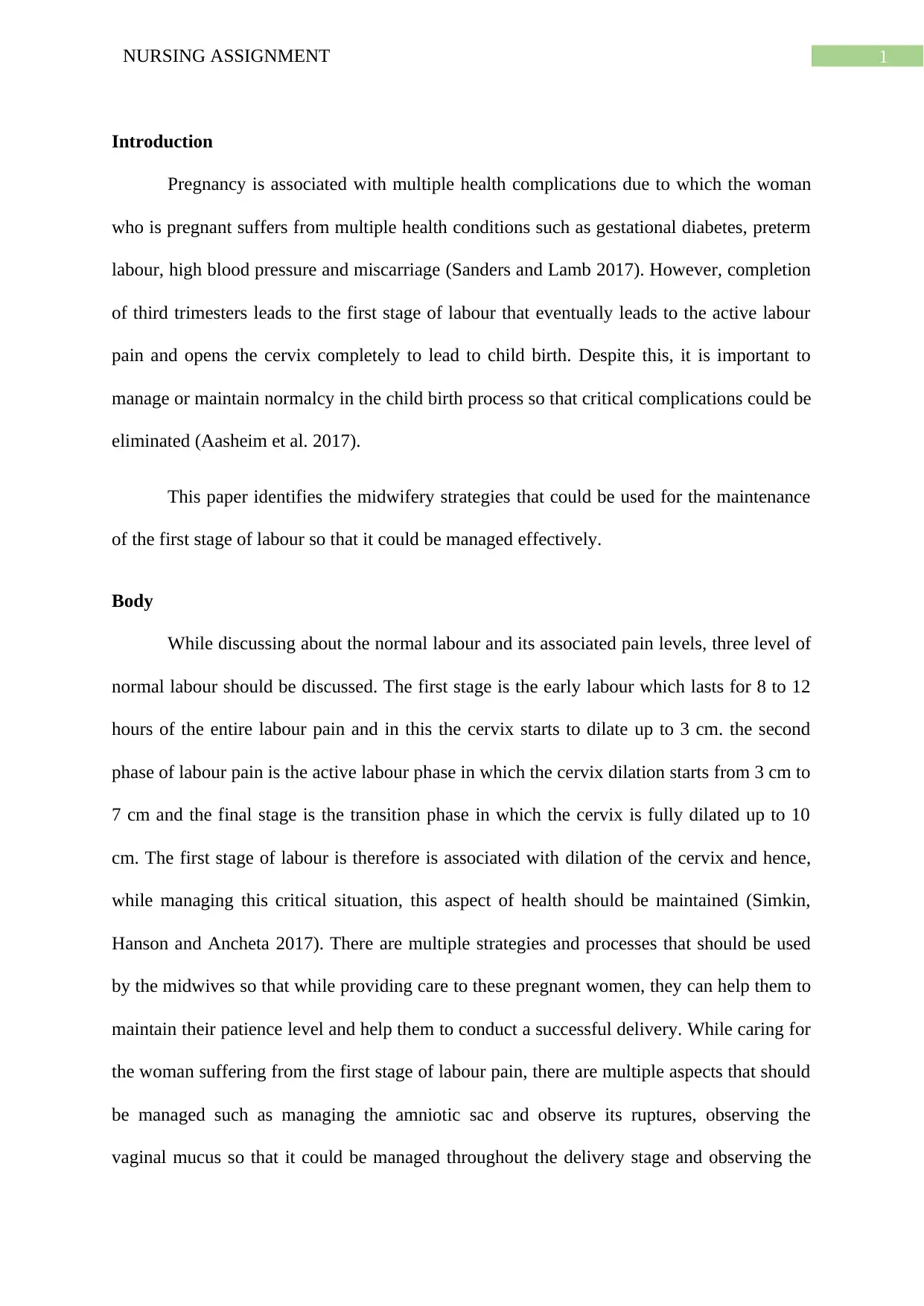
1NURSING ASSIGNMENT
Introduction
Pregnancy is associated with multiple health complications due to which the woman
who is pregnant suffers from multiple health conditions such as gestational diabetes, preterm
labour, high blood pressure and miscarriage (Sanders and Lamb 2017). However, completion
of third trimesters leads to the first stage of labour that eventually leads to the active labour
pain and opens the cervix completely to lead to child birth. Despite this, it is important to
manage or maintain normalcy in the child birth process so that critical complications could be
eliminated (Aasheim et al. 2017).
This paper identifies the midwifery strategies that could be used for the maintenance
of the first stage of labour so that it could be managed effectively.
Body
While discussing about the normal labour and its associated pain levels, three level of
normal labour should be discussed. The first stage is the early labour which lasts for 8 to 12
hours of the entire labour pain and in this the cervix starts to dilate up to 3 cm. the second
phase of labour pain is the active labour phase in which the cervix dilation starts from 3 cm to
7 cm and the final stage is the transition phase in which the cervix is fully dilated up to 10
cm. The first stage of labour is therefore is associated with dilation of the cervix and hence,
while managing this critical situation, this aspect of health should be maintained (Simkin,
Hanson and Ancheta 2017). There are multiple strategies and processes that should be used
by the midwives so that while providing care to these pregnant women, they can help them to
maintain their patience level and help them to conduct a successful delivery. While caring for
the woman suffering from the first stage of labour pain, there are multiple aspects that should
be managed such as managing the amniotic sac and observe its ruptures, observing the
vaginal mucus so that it could be managed throughout the delivery stage and observing the
Introduction
Pregnancy is associated with multiple health complications due to which the woman
who is pregnant suffers from multiple health conditions such as gestational diabetes, preterm
labour, high blood pressure and miscarriage (Sanders and Lamb 2017). However, completion
of third trimesters leads to the first stage of labour that eventually leads to the active labour
pain and opens the cervix completely to lead to child birth. Despite this, it is important to
manage or maintain normalcy in the child birth process so that critical complications could be
eliminated (Aasheim et al. 2017).
This paper identifies the midwifery strategies that could be used for the maintenance
of the first stage of labour so that it could be managed effectively.
Body
While discussing about the normal labour and its associated pain levels, three level of
normal labour should be discussed. The first stage is the early labour which lasts for 8 to 12
hours of the entire labour pain and in this the cervix starts to dilate up to 3 cm. the second
phase of labour pain is the active labour phase in which the cervix dilation starts from 3 cm to
7 cm and the final stage is the transition phase in which the cervix is fully dilated up to 10
cm. The first stage of labour is therefore is associated with dilation of the cervix and hence,
while managing this critical situation, this aspect of health should be maintained (Simkin,
Hanson and Ancheta 2017). There are multiple strategies and processes that should be used
by the midwives so that while providing care to these pregnant women, they can help them to
maintain their patience level and help them to conduct a successful delivery. While caring for
the woman suffering from the first stage of labour pain, there are multiple aspects that should
be managed such as managing the amniotic sac and observe its ruptures, observing the
vaginal mucus so that it could be managed throughout the delivery stage and observing the
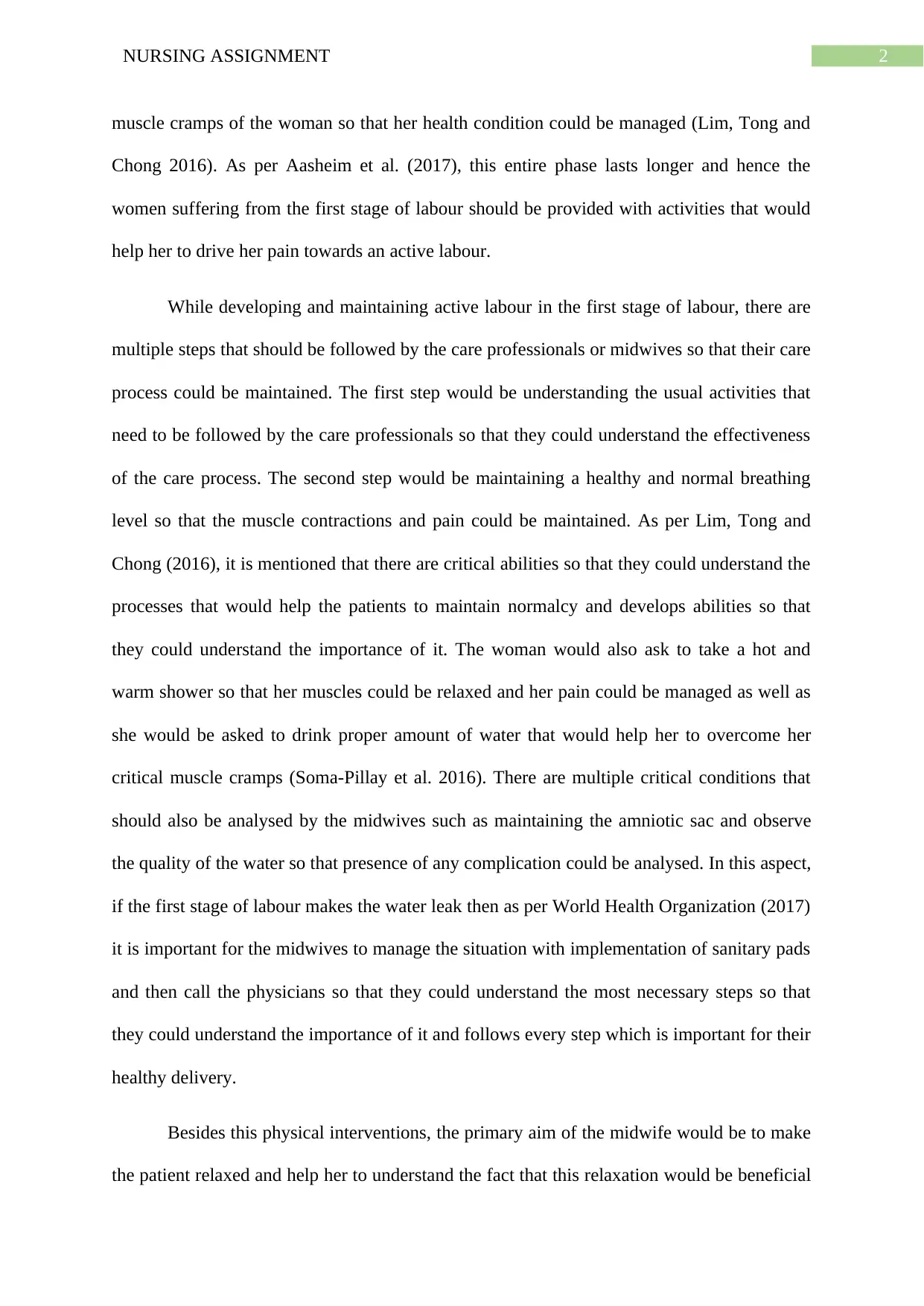
2NURSING ASSIGNMENT
muscle cramps of the woman so that her health condition could be managed (Lim, Tong and
Chong 2016). As per Aasheim et al. (2017), this entire phase lasts longer and hence the
women suffering from the first stage of labour should be provided with activities that would
help her to drive her pain towards an active labour.
While developing and maintaining active labour in the first stage of labour, there are
multiple steps that should be followed by the care professionals or midwives so that their care
process could be maintained. The first step would be understanding the usual activities that
need to be followed by the care professionals so that they could understand the effectiveness
of the care process. The second step would be maintaining a healthy and normal breathing
level so that the muscle contractions and pain could be maintained. As per Lim, Tong and
Chong (2016), it is mentioned that there are critical abilities so that they could understand the
processes that would help the patients to maintain normalcy and develops abilities so that
they could understand the importance of it. The woman would also ask to take a hot and
warm shower so that her muscles could be relaxed and her pain could be managed as well as
she would be asked to drink proper amount of water that would help her to overcome her
critical muscle cramps (Soma-Pillay et al. 2016). There are multiple critical conditions that
should also be analysed by the midwives such as maintaining the amniotic sac and observe
the quality of the water so that presence of any complication could be analysed. In this aspect,
if the first stage of labour makes the water leak then as per World Health Organization (2017)
it is important for the midwives to manage the situation with implementation of sanitary pads
and then call the physicians so that they could understand the most necessary steps so that
they could understand the importance of it and follows every step which is important for their
healthy delivery.
Besides this physical interventions, the primary aim of the midwife would be to make
the patient relaxed and help her to understand the fact that this relaxation would be beneficial
muscle cramps of the woman so that her health condition could be managed (Lim, Tong and
Chong 2016). As per Aasheim et al. (2017), this entire phase lasts longer and hence the
women suffering from the first stage of labour should be provided with activities that would
help her to drive her pain towards an active labour.
While developing and maintaining active labour in the first stage of labour, there are
multiple steps that should be followed by the care professionals or midwives so that their care
process could be maintained. The first step would be understanding the usual activities that
need to be followed by the care professionals so that they could understand the effectiveness
of the care process. The second step would be maintaining a healthy and normal breathing
level so that the muscle contractions and pain could be maintained. As per Lim, Tong and
Chong (2016), it is mentioned that there are critical abilities so that they could understand the
processes that would help the patients to maintain normalcy and develops abilities so that
they could understand the importance of it. The woman would also ask to take a hot and
warm shower so that her muscles could be relaxed and her pain could be managed as well as
she would be asked to drink proper amount of water that would help her to overcome her
critical muscle cramps (Soma-Pillay et al. 2016). There are multiple critical conditions that
should also be analysed by the midwives such as maintaining the amniotic sac and observe
the quality of the water so that presence of any complication could be analysed. In this aspect,
if the first stage of labour makes the water leak then as per World Health Organization (2017)
it is important for the midwives to manage the situation with implementation of sanitary pads
and then call the physicians so that they could understand the most necessary steps so that
they could understand the importance of it and follows every step which is important for their
healthy delivery.
Besides this physical interventions, the primary aim of the midwife would be to make
the patient relaxed and help her to understand the fact that this relaxation would be beneficial
⊘ This is a preview!⊘
Do you want full access?
Subscribe today to unlock all pages.

Trusted by 1+ million students worldwide
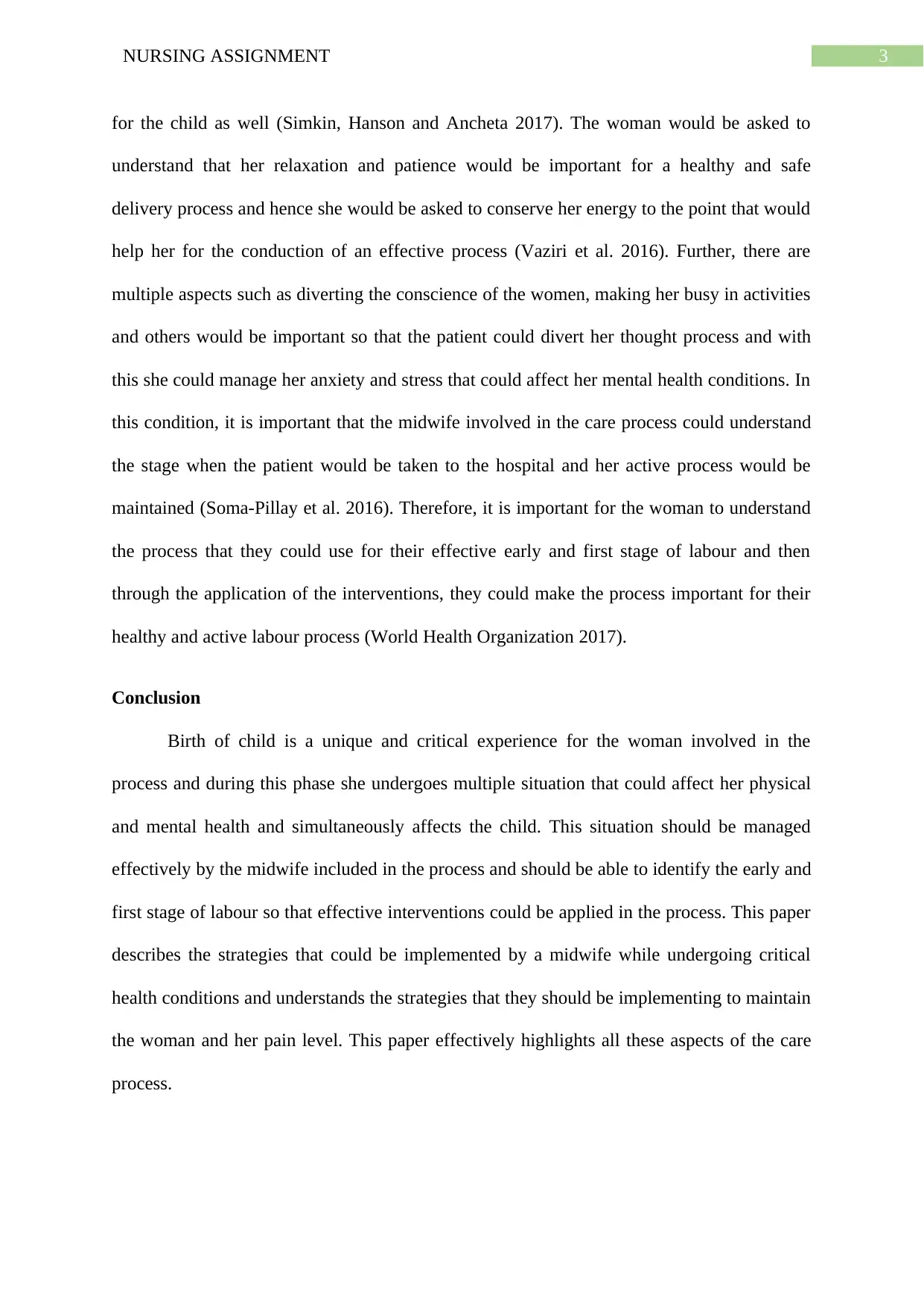
3NURSING ASSIGNMENT
for the child as well (Simkin, Hanson and Ancheta 2017). The woman would be asked to
understand that her relaxation and patience would be important for a healthy and safe
delivery process and hence she would be asked to conserve her energy to the point that would
help her for the conduction of an effective process (Vaziri et al. 2016). Further, there are
multiple aspects such as diverting the conscience of the women, making her busy in activities
and others would be important so that the patient could divert her thought process and with
this she could manage her anxiety and stress that could affect her mental health conditions. In
this condition, it is important that the midwife involved in the care process could understand
the stage when the patient would be taken to the hospital and her active process would be
maintained (Soma-Pillay et al. 2016). Therefore, it is important for the woman to understand
the process that they could use for their effective early and first stage of labour and then
through the application of the interventions, they could make the process important for their
healthy and active labour process (World Health Organization 2017).
Conclusion
Birth of child is a unique and critical experience for the woman involved in the
process and during this phase she undergoes multiple situation that could affect her physical
and mental health and simultaneously affects the child. This situation should be managed
effectively by the midwife included in the process and should be able to identify the early and
first stage of labour so that effective interventions could be applied in the process. This paper
describes the strategies that could be implemented by a midwife while undergoing critical
health conditions and understands the strategies that they should be implementing to maintain
the woman and her pain level. This paper effectively highlights all these aspects of the care
process.
for the child as well (Simkin, Hanson and Ancheta 2017). The woman would be asked to
understand that her relaxation and patience would be important for a healthy and safe
delivery process and hence she would be asked to conserve her energy to the point that would
help her for the conduction of an effective process (Vaziri et al. 2016). Further, there are
multiple aspects such as diverting the conscience of the women, making her busy in activities
and others would be important so that the patient could divert her thought process and with
this she could manage her anxiety and stress that could affect her mental health conditions. In
this condition, it is important that the midwife involved in the care process could understand
the stage when the patient would be taken to the hospital and her active process would be
maintained (Soma-Pillay et al. 2016). Therefore, it is important for the woman to understand
the process that they could use for their effective early and first stage of labour and then
through the application of the interventions, they could make the process important for their
healthy and active labour process (World Health Organization 2017).
Conclusion
Birth of child is a unique and critical experience for the woman involved in the
process and during this phase she undergoes multiple situation that could affect her physical
and mental health and simultaneously affects the child. This situation should be managed
effectively by the midwife included in the process and should be able to identify the early and
first stage of labour so that effective interventions could be applied in the process. This paper
describes the strategies that could be implemented by a midwife while undergoing critical
health conditions and understands the strategies that they should be implementing to maintain
the woman and her pain level. This paper effectively highlights all these aspects of the care
process.
Paraphrase This Document
Need a fresh take? Get an instant paraphrase of this document with our AI Paraphraser
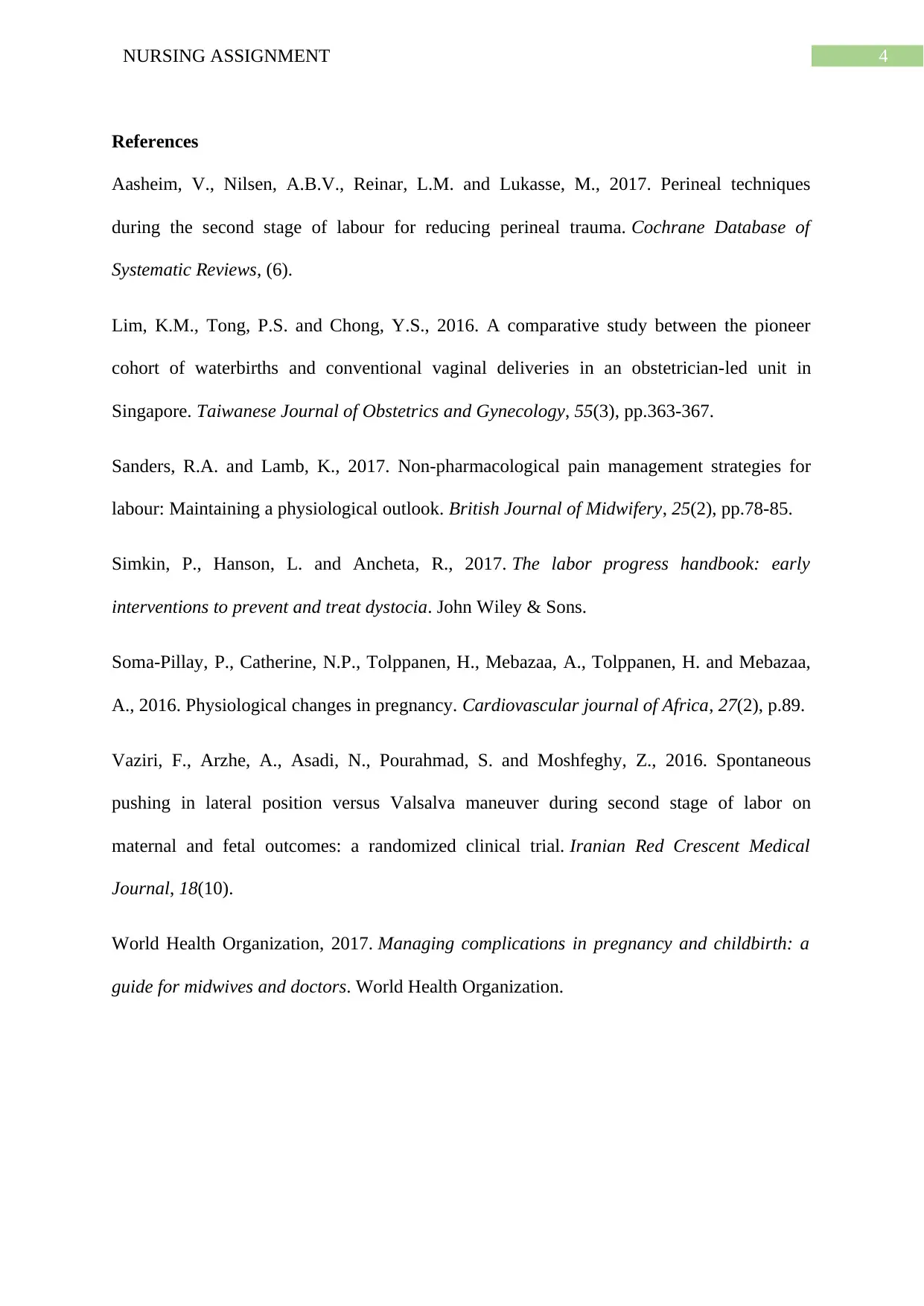
4NURSING ASSIGNMENT
References
Aasheim, V., Nilsen, A.B.V., Reinar, L.M. and Lukasse, M., 2017. Perineal techniques
during the second stage of labour for reducing perineal trauma. Cochrane Database of
Systematic Reviews, (6).
Lim, K.M., Tong, P.S. and Chong, Y.S., 2016. A comparative study between the pioneer
cohort of waterbirths and conventional vaginal deliveries in an obstetrician-led unit in
Singapore. Taiwanese Journal of Obstetrics and Gynecology, 55(3), pp.363-367.
Sanders, R.A. and Lamb, K., 2017. Non-pharmacological pain management strategies for
labour: Maintaining a physiological outlook. British Journal of Midwifery, 25(2), pp.78-85.
Simkin, P., Hanson, L. and Ancheta, R., 2017. The labor progress handbook: early
interventions to prevent and treat dystocia. John Wiley & Sons.
Soma-Pillay, P., Catherine, N.P., Tolppanen, H., Mebazaa, A., Tolppanen, H. and Mebazaa,
A., 2016. Physiological changes in pregnancy. Cardiovascular journal of Africa, 27(2), p.89.
Vaziri, F., Arzhe, A., Asadi, N., Pourahmad, S. and Moshfeghy, Z., 2016. Spontaneous
pushing in lateral position versus Valsalva maneuver during second stage of labor on
maternal and fetal outcomes: a randomized clinical trial. Iranian Red Crescent Medical
Journal, 18(10).
World Health Organization, 2017. Managing complications in pregnancy and childbirth: a
guide for midwives and doctors. World Health Organization.
References
Aasheim, V., Nilsen, A.B.V., Reinar, L.M. and Lukasse, M., 2017. Perineal techniques
during the second stage of labour for reducing perineal trauma. Cochrane Database of
Systematic Reviews, (6).
Lim, K.M., Tong, P.S. and Chong, Y.S., 2016. A comparative study between the pioneer
cohort of waterbirths and conventional vaginal deliveries in an obstetrician-led unit in
Singapore. Taiwanese Journal of Obstetrics and Gynecology, 55(3), pp.363-367.
Sanders, R.A. and Lamb, K., 2017. Non-pharmacological pain management strategies for
labour: Maintaining a physiological outlook. British Journal of Midwifery, 25(2), pp.78-85.
Simkin, P., Hanson, L. and Ancheta, R., 2017. The labor progress handbook: early
interventions to prevent and treat dystocia. John Wiley & Sons.
Soma-Pillay, P., Catherine, N.P., Tolppanen, H., Mebazaa, A., Tolppanen, H. and Mebazaa,
A., 2016. Physiological changes in pregnancy. Cardiovascular journal of Africa, 27(2), p.89.
Vaziri, F., Arzhe, A., Asadi, N., Pourahmad, S. and Moshfeghy, Z., 2016. Spontaneous
pushing in lateral position versus Valsalva maneuver during second stage of labor on
maternal and fetal outcomes: a randomized clinical trial. Iranian Red Crescent Medical
Journal, 18(10).
World Health Organization, 2017. Managing complications in pregnancy and childbirth: a
guide for midwives and doctors. World Health Organization.
1 out of 5
Your All-in-One AI-Powered Toolkit for Academic Success.
+13062052269
info@desklib.com
Available 24*7 on WhatsApp / Email
![[object Object]](/_next/static/media/star-bottom.7253800d.svg)
Unlock your academic potential
Copyright © 2020–2025 A2Z Services. All Rights Reserved. Developed and managed by ZUCOL.


